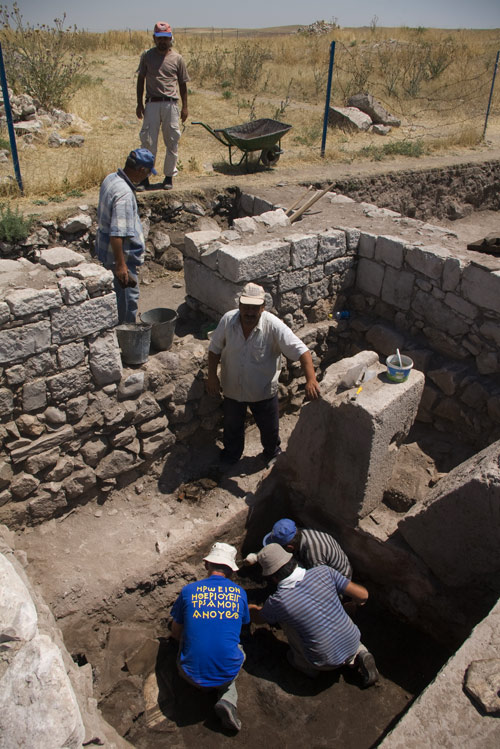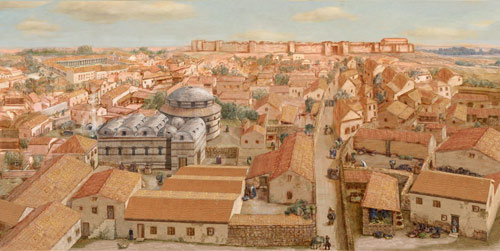 Traveling Exhibitions
Traveling Exhibitions Traveling Works of Art
Traveling Works of Art Conservation Projects
Conservation Projects Excavations
Excavations Fellows
Fellows Exchanges & Collaborations
Exchanges & Collaborations Multiple Items
Multiple Items
The Met Around the World presents the Met’s work via the global scope of its collection and as it extends across the nation and the world through a variety of domestic and international initiatives and programs, including exhibitions, excavations, fellowships, professional exchanges, conservation projects, and traveling works of art.
The Met Around the World is designed and maintained by the Office of the Director.
Traveling
Exhibitions
The Met organizes large and small exhibitions that travel beyond the Museum's walls, extending our scholarship to institutions across the world. See our national and international traveling exhibition program from 2009 to the present.
Traveling
Works of Art
The Met lends works of art to exhibitions and institutions worldwide to expose its collection to the broadest possible audience. See our current national and international loans program.
Conservation
Projects
The preservation of works of art is a fundamental part of the Met's mission. Our work in this area includes treating works of art from other collections. See our national and international conservation activities from 2009 to the present.
Excavations
The Met has conducted excavations for over 100 years in direct partnership with source countries at some of the most important archaeological sites in the world. Today we continue this tradition in order to gain greater understanding of our ancient collections. See our national and international excavation program from the Met's founding to the present.
Fellows
The Met hosts students, scholars, and museum professionals so that they can learn from our staff and pursue independent research in the context of the Met's exceptional resources and facilities. See the activities of our current national and international fellows.
Exchanges & Collaborations
The Met's work takes many forms, from participation in exchange programs at partnering institutions and worldwide symposia to advising on a range of museum issues. These activities contribute to our commitment to advancing the work of the larger, global community of art museums. See our national and international exchange program and other collaborations from 2009 to the present.
 Excavation of a Byzantine wine-pressing tank in 2009 in buildings attached to the Lower City Church at Amorium. © The Amorium Excavations Project.
Excavation of a Byzantine wine-pressing tank in 2009 in buildings attached to the Lower City Church at Amorium. © The Amorium Excavations Project. Byzantine closure slab reassembled from fragments on site by members of the Amorium Excavations Project stone conservation team. © The Amorium Excavations Project.
Byzantine closure slab reassembled from fragments on site by members of the Amorium Excavations Project stone conservation team. © The Amorium Excavations Project. Artist's impression of the Byzantine Lower City at Amorium in ca. A.D. 800, showing the bathhouse and wine-making installations (by Tatiana Meltsem). © The Amorium Excavations Project.
Artist's impression of the Byzantine Lower City at Amorium in ca. A.D. 800, showing the bathhouse and wine-making installations (by Tatiana Meltsem). © The Amorium Excavations Project.
[active] Turkey
1987–present
The site, located in the village of Hisarköy, Turkey, comprises a large prehistoric man-made mound, a fortified lower city, and an extensive necropolis. Occupation has been attested for the Early Bronze Age and the Phrygian, Hellenistic, and Roman periods, but Amorium attained its greatest prominence during the seventh through eleventh centuries A.D., when it became a major provincial center and military headquarters.
The excavations have provided ample evidence for the fact that it was one of the few cities in Anatolia that continued to flourish under the Byzantines. It was also the hometown of a short-lived dynasty of Byzantine emperors in the ninth century—that of Michael II, his son Theophilus, and his grandson Michael III. The most famous event in the city’s history took place in A.D. 838 during Theophilus’ reign, when the city was attacked and, after a twelve-day siege, was captured and sacked by Arab forces led by the Abbasid caliph al-Mu‛tasim. Startling evidence of the destruction was uncovered in 2008, when the remains of two bodies—apparently victims of the siege—were unearthed. In addition, stretches of the fortification walls, a large church, a bathhouse, and several industrial installations, including wine presses, have been uncovered.
Funded by The Leon Levy Foundation, The Stavros Niarchos Foundation, and others.
Made possible by The Adelaide and Milton de Groot Fund, in memory of the de Groot and Hawley Families.


